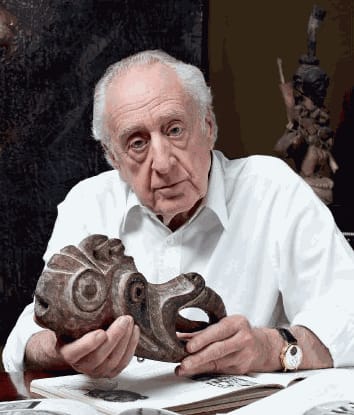
On 16 September 2014, Sotheby’s Paris will offer the collection of Oceanic art from Polynesia and Melanesia formed by the late Murray Frum. It is the most significant group to come to market in the last thirty years. The Collection of approximately 70 works contains a rich variety of exceptionally rare objects with distinguished provenance. Unique in these times are the group of pre-contact Polynesian pieces, which form the heart of the collection. The collection as a whole is valued at € 6 million to € 9 million; with about a dozen items priced at under € 5,000,-.
Murray Frum (1931-2013) was a Canadian real estate developer. His parents had emigrated to Canada from Poland in 1930, and he grew up in Canada. It was a visit to New York in the late 1950s to the Metropolitan Museum of Art in New York that sparked his passion for collecting. Over the next fifty years, he assembled an extraordinarily diverse collection of African, Oceanic, Pre-Columbian, Silver, Art Deco, and Renaissance art as well as Canadian paintings. Murray became known not only for his discerning eye and tremendous curiosity about the objects which he displayed elegantly in his home which he built with the modernist architects (Ron Thom, Brigitte Shim and Howard Sutcliffe), but he was also a tremendously generous philanthropic man. He loaned objects from his collection around the world, and his African collection was published and exhibited in 1980 by the great African art curator, William Fagg, ex-keeper of the British Museum. In addition, he gave part of his African art collection to the Art Gallery of Ontario. His deliberate choice of the Art Gallery for his collection demonstrated Frum’s deep conviction that tribal art should be considered as art, and not as ethnographical specimens.
 Head of a Staff God, Rarotonga, Cook Islands This magnificent sculpture is a sacred object from one of the rarest sculptural traditions in Polynesia. Formerly in the James Hooper Collection, it is the upper part of a large staff, which would have measured around 12 feet in length. The missionary John Williams claims to have destroyed the majority of these images during his time on Rarotonga between 1827-1828. Only twenty staff gods survived the early 19th century missionary presence on this small island, and most are today in museums. The Frum staff god is the first of this quality to come to auction in nearly 20 years. Estimated € 1,5 – 2,5 million.
Head of a Staff God, Rarotonga, Cook Islands This magnificent sculpture is a sacred object from one of the rarest sculptural traditions in Polynesia. Formerly in the James Hooper Collection, it is the upper part of a large staff, which would have measured around 12 feet in length. The missionary John Williams claims to have destroyed the majority of these images during his time on Rarotonga between 1827-1828. Only twenty staff gods survived the early 19th century missionary presence on this small island, and most are today in museums. The Frum staff god is the first of this quality to come to auction in nearly 20 years. Estimated € 1,5 – 2,5 million.